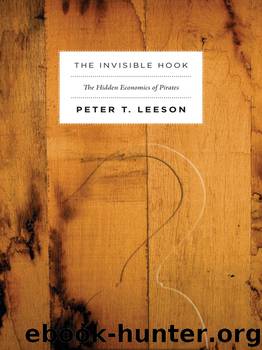The Invisible Hook by Leeson Peter T

Author:Leeson, Peter T. [Leeson, Peter T.]
Language: eng
Format: epub
ISBN: 978-1-4008-2986-6
Publisher: Princeton University Press
Published: 2009-04-09T04:00:00+00:00
Pirate torture, while often heinous, was rarely arbitrary. Instead, pirates primarily used grizzly tactics to serve their profit-seeking purpose. Through barbarous torture, pirates created and diligently tended to their reputation for insanity, cruelty, and murderous destruction. In doing so, these “Fury of unreasonable Hell,” as one contemporary styled them, “gave you the Liveliest Picture of Hell,” fostering a brand name so frightening few dared to resist them. Captives relinquished valuables they might otherwise have hidden from their attackers and some authorities thought twice before capturing and condemning pirates for fear of retribution against them and their citizens. Although pirates certainly appeared to be, as one court put it, “Instigated by the Devil,” in reality “the Folly and Madness among Pyrates” so many pirate contemporaries described was rational, reasonable, and even carefully calculated to achieve a brand name as barely better than, or perhaps worse than, wild animals.
Besides torturing their captives for profit, pirates also tortured for “justice.” Allegedly wronged by their masters when they sailed as common tars on merchant ships, pirates were more than happy to punish merchant captains they came upon whom one of their members had formerly suffered under or whose crew claimed was predatory. On the one hand, pirate justice for merchant ship captains may have operated to tame these captains’ abuses, contributing to merchant sailors’ welfare in cases when government was unable to do so. On the other hand, absent any controls, pirate justice could be unfair, excessive, and in more than a few cases was probably totally unwarranted.
Finally, although pirates overwhelmingly tortured “with purpose,” there are cases that were no more than sadism as well. I’ve focused on the former since the latter is well known and paints a distorted picture of pirate torture that wrongly portrays brutality for sport as the rule instead of the exception. Nevertheless, we shouldn’t forget that, like a minority of merchant captains, navy captains, and landlubbers, a minority of pirates were also simply psychopaths. Francis Spriggs, for example, forced merchant captain Richard Hawkins to eat “a Dish of Candles” for his amusement. But Spriggs’s wanton torture looks like fraternity hazing next to the tortures of truly sadistic pirates, such as Edward Low. Low, for example, burned one victim alive for no other reason than, “being a greazy Fellow,” he thought he “would fry well in the Fire.”
Even Low, however, didn’t brutalize everyone he encountered. Rather, he often reserved his perverse passions for times when unleashing them could profit him. As noted in an earlier example in this chapter, for instance, Low released English prisoners he captured with whom he had no axe to grind. More generally, Low seems to have recognized the importance of not overindulging his sadistic desires. Doing so would undermine his crew’s ultimate goal—to take prizes with as little resistance as possible. In one case, for example, Low captured an old man who he used as a hostage to extort water from the governor of Madeira. The pirates “threaten’d to hang [the old man] at
Download
This site does not store any files on its server. We only index and link to content provided by other sites. Please contact the content providers to delete copyright contents if any and email us, we'll remove relevant links or contents immediately.
| Africa | Americas |
| Arctic & Antarctica | Asia |
| Australia & Oceania | Europe |
| Middle East | Russia |
| United States | World |
| Ancient Civilizations | Military |
| Historical Study & Educational Resources |
Cecilia; Or, Memoirs of an Heiress — Volume 1 by Fanny Burney(32062)
Cecilia; Or, Memoirs of an Heiress — Volume 3 by Fanny Burney(31458)
Cecilia; Or, Memoirs of an Heiress — Volume 2 by Fanny Burney(31409)
The Secret History by Donna Tartt(18163)
Sapiens: A Brief History of Humankind by Yuval Noah Harari(13990)
Leonardo da Vinci by Walter Isaacson(12804)
The Radium Girls by Kate Moore(11621)
Sapiens by Yuval Noah Harari(5123)
How Democracies Die by Steven Levitsky & Daniel Ziblatt(4958)
The Wind in My Hair by Masih Alinejad(4843)
Homo Deus: A Brief History of Tomorrow by Yuval Noah Harari(4690)
Endurance: Shackleton's Incredible Voyage by Alfred Lansing(4506)
Man's Search for Meaning by Viktor Frankl(4275)
The Silk Roads by Peter Frankopan(4274)
Millionaire: The Philanderer, Gambler, and Duelist Who Invented Modern Finance by Janet Gleeson(4099)
The Rape of Nanking by Iris Chang(4023)
Hitler in Los Angeles by Steven J. Ross(3798)
The Motorcycle Diaries by Ernesto Che Guevara(3787)
Joan of Arc by Mary Gordon(3782)
